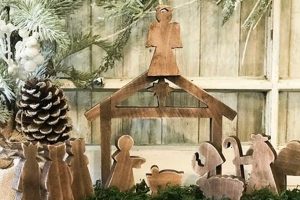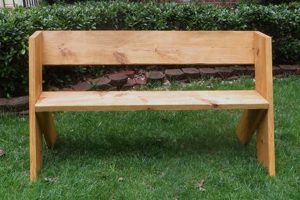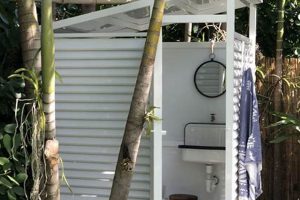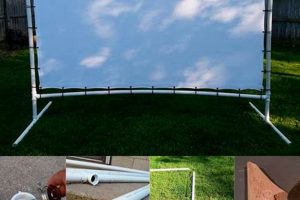The construction of small, independent surfaces designed for exterior use, created by individuals rather than purchased pre-made, represents a common approach to furnishing outdoor spaces. These projects often involve readily available materials and basic construction techniques, resulting in a functional and personalized addition to patios, decks, or gardens. For example, reclaimed wood, concrete blocks, or metal scraps can be repurposed to form a durable and aesthetically pleasing surface.
The appeal of such projects lies in several factors. Economically, constructing one’s own furniture can be more cost-effective than purchasing manufactured alternatives. Furthermore, these ventures allow for customization to perfectly fit specific space constraints and aesthetic preferences. Historically, self-sufficiency in furniture creation has been a hallmark of various cultures and periods, reflecting a desire for resourcefulness and individual expression. Beyond functionality, the act of building furniture provides a sense of accomplishment and promotes sustainable practices through the reuse of materials.
The subsequent discussion will delve into various design options, material considerations, and step-by-step construction processes relevant to undertaking these types of projects. Considerations will include weather resistance, structural stability, and aesthetic integration with existing outdoor decor.
Construction Recommendations for Exterior Auxiliary Surfaces
The following recommendations aim to provide guidance for constructing durable and aesthetically pleasing auxiliary surfaces intended for outdoor environments. Adherence to these principles will enhance the longevity and functionality of the finished piece.
Tip 1: Material Selection: Prioritize weather-resistant materials. Treated lumber, cedar, redwood, or composite decking offer superior resistance to moisture, insects, and decay compared to untreated options. Consider the long-term environmental exposure when making material choices.
Tip 2: Protective Coatings: Apply appropriate sealants or finishes. Exterior-grade paints, stains, or varnishes provide a protective barrier against UV radiation and moisture penetration. Reapply coatings periodically to maintain their effectiveness and prolong the material’s lifespan.
Tip 3: Structural Integrity: Ensure adequate support and stability. Utilize robust joinery techniques, such as screws, bolts, or mortise-and-tenon joints, to create a solid and stable structure. Reinforce weak points with additional bracing or supports as needed.
Tip 4: Drainage Considerations: Incorporate drainage features to prevent water accumulation. Design the surface with a slight slope or include gaps between boards to allow water to drain freely. This minimizes the risk of rot and extends the furniture’s lifespan.
Tip 5: Hardware Selection: Utilize corrosion-resistant hardware. Stainless steel or galvanized fasteners are essential for outdoor applications. These materials resist rust and corrosion, ensuring that the connections remain secure over time.
Tip 6: Design for Intended Use: Consider the intended purpose of the surface. Height, size, and weight capacity should be appropriate for the anticipated use. A surface intended for supporting heavy objects requires a more robust design than one designed for purely decorative purposes.
Tip 7: Surface Treatment: Prepare surfaces properly before assembly and finishing. Sanding, cleaning, and priming will ensure proper adhesion of coatings and enhance the overall aesthetic appeal of the finished product.
By adhering to these recommendations, the resulting construction will be better suited to withstand the rigors of outdoor use, providing a durable and attractive addition to any exterior space.
The subsequent section will address specific design considerations and provide detailed construction plans for a variety of styles and materials.
1. Material Selection
Material selection is paramount in the design and construction of independent exterior surfaces. The choice of materials directly influences the durability, longevity, and aesthetic appeal of the finished project. In the context of an outdoor auxiliary surface, improper material selection can lead to premature failure due to environmental factors such as moisture, sunlight, and temperature fluctuations. For example, using untreated softwood in a humid climate will likely result in rot and structural instability within a short period. Conversely, selecting weather-resistant materials like treated lumber, cedar, or teak extends the lifespan of the structure and reduces the need for frequent repairs or replacements. The properties of the chosen material dictate its ability to withstand the elements and maintain its structural integrity over time.
Considerations beyond weather resistance include the aesthetic properties of the material and its suitability for the intended design. Reclaimed wood, for instance, offers a rustic aesthetic and contributes to sustainable building practices. However, it may require additional preparation to ensure a smooth and stable surface. Metal, such as aluminum or steel, provides a modern aesthetic and offers high strength and durability, but it may require specialized tools and techniques for fabrication. Concrete offers a unique aesthetic and can be molded into various shapes, but it is heavy and requires reinforcement to prevent cracking. Each material presents unique advantages and disadvantages that must be carefully weighed against the specific design requirements and environmental conditions.
Ultimately, the selection process involves balancing aesthetic preferences, structural requirements, and environmental considerations. The practical significance of a well-informed material selection cannot be overstated; it directly impacts the long-term cost-effectiveness and usability of the exterior surface. Challenges may arise in balancing budget constraints with desired material properties, but a thorough understanding of material characteristics is crucial for making informed decisions that optimize the performance and longevity of the finished project. Prioritizing weather resistance and structural integrity will lead to a functional and aesthetically pleasing addition to any outdoor space.
2. Structural Integrity
Structural integrity is a foundational requirement for any self-constructed exterior surface. It ensures the safe and reliable performance of the structure under various environmental conditions and applied loads. The absence of adequate structural integrity compromises the usability and longevity of the surface, rendering it potentially hazardous.
- Joint Strength and Stability
Joints represent critical points within the structure. Weak or improperly constructed joints can lead to instability and eventual failure. Employing appropriate joinery techniques, such as mortise-and-tenon, dovetail, or robust screw connections, is essential. For example, a table constructed with poorly secured legs may collapse under the weight of objects placed upon it. Selecting the correct type of fastener for the material being used is also crucial; screws designed for softwood may not provide sufficient holding power in hardwood.
- Load-Bearing Capacity
The load-bearing capacity dictates the maximum weight the structure can safely support. It is influenced by material selection, design, and construction techniques. Overestimating the load-bearing capacity can result in catastrophic failure. Consider a surface intended for holding potted plants; the weight of the plants, combined with the weight of wet soil, can exceed the surface’s capacity if not properly designed. Reinforcements, such as additional supports or thicker materials, can increase the load-bearing capacity.
- Resistance to Environmental Stress
Outdoor structures are subjected to various environmental stressors, including wind, rain, temperature fluctuations, and ultraviolet (UV) radiation. These factors can degrade materials and weaken structural components over time. A table left exposed to the elements without adequate protection may experience warping, cracking, or corrosion, ultimately compromising its structural integrity. Utilizing weather-resistant materials and applying protective coatings can mitigate these effects.
- Material Selection and Compatibility
The choice of materials directly impacts structural integrity. Different materials possess varying strengths, stiffness, and resistance to environmental factors. Combining incompatible materials can lead to problems due to differential expansion and contraction. For instance, using untreated steel fasteners with pressure-treated lumber can lead to accelerated corrosion of the fasteners, weakening the connections. Selecting materials that are compatible and appropriate for the intended application is crucial.
The interrelationship between these facets underlines the holistic nature of structural integrity in self-constructed exterior surfaces. Neglecting any one facet compromises the overall stability and usability of the finished piece. Furthermore, prioritizing structural integrity not only ensures safety but also enhances the long-term value and aesthetic appeal of the project.
3. Weather Resistance
Weather resistance is a critical factor in the design and construction of self-made exterior auxiliary surfaces. The capacity of the finished product to withstand environmental conditions directly impacts its longevity, functionality, and aesthetic appeal. Inadequate attention to weather resistance can result in premature degradation and structural failure.
- Material Selection and Environmental Suitability
The selection of materials must account for the specific climate in which the table will reside. For instance, in regions with high humidity and frequent rainfall, materials like treated lumber, cedar, or teak are preferable due to their inherent resistance to moisture and decay. Conversely, untreated softwood would be unsuitable, leading to rapid deterioration. Choosing materials that are naturally resistant to local environmental conditions is crucial for long-term durability.
- Protective Coatings and Sealants
Even with weather-resistant materials, protective coatings and sealants provide an additional layer of defense against the elements. Exterior-grade paints, stains, and varnishes form a barrier against moisture, UV radiation, and fungal growth. Regular application and maintenance of these coatings are essential to maintain their protective properties. For example, a clear coat applied to a wooden table can prevent water from penetrating the wood fibers, minimizing the risk of warping or cracking.
- Drainage and Ventilation
Design considerations should include provisions for drainage and ventilation to prevent water accumulation and promote air circulation. A table design that allows water to pool on the surface will accelerate decay, even with weather-resistant materials. Incorporating gaps between boards, a slight slope on the surface, or drainage holes can facilitate water runoff. Adequate ventilation prevents the buildup of moisture within the structure, further mitigating the risk of rot.
- Fastener Selection and Corrosion Resistance
The choice of fasteners used in the construction is equally important for weather resistance. Standard steel screws and nails are prone to corrosion in outdoor environments, which can weaken joints and lead to structural failure. Stainless steel or galvanized fasteners offer superior corrosion resistance and should be used exclusively for exterior projects. The use of appropriate fasteners ensures that the connections remain secure over time, even under prolonged exposure to moisture and other environmental factors.
The multifaceted nature of weather resistance necessitates a comprehensive approach that encompasses material selection, protective coatings, drainage considerations, and fastener selection. By addressing each of these aspects, the resulting self-constructed exterior surface is better equipped to withstand the rigors of outdoor use, providing a durable and aesthetically pleasing addition to any exterior space. The lack of attention to any single area compromises overall resilience.
4. Design Aesthetics
Design aesthetics represents a crucial consideration in the creation of independent exterior surfaces. The visual appeal and stylistic integration of the finished piece directly influence its perceived value and contribution to the overall ambiance of the outdoor space. Ignoring aesthetic considerations can result in a functional, yet visually unappealing, addition that detracts from the intended environment.
- Harmonization with Existing Dcor
The aesthetic design should complement the existing outdoor furniture, landscaping, and architectural style. A modern, minimalist exterior surface might clash with a rustic, traditional patio setting, whereas a repurposed wooden surface would blend more seamlessly. Matching colors, materials, and design elements creates a cohesive and visually pleasing environment. For example, if the patio furniture features dark metal frames, a surface with similar metal accents would contribute to a harmonious aesthetic.
- Material Selection and Visual Texture
The choice of materials significantly impacts the overall aesthetic. Different materials possess unique visual textures and characteristics. Reclaimed wood offers a rustic, weathered aesthetic, while polished concrete provides a modern, industrial look. The material’s color, grain pattern, and surface finish contribute to the overall visual appeal. Careful consideration of these aspects ensures that the material aligns with the desired aesthetic and enhances the visual interest of the structure.
- Form and Proportion
The shape and dimensions of the exterior surface should be thoughtfully considered to ensure visual balance and functionality. A disproportionately large surface can overwhelm a small patio, while a surface that is too small may lack utility. The form should complement the surrounding elements and provide adequate space for its intended purpose. For example, a round surface might be more suitable for a conversational seating area, while a rectangular surface might be more practical for dining.
- Personalization and Customization
Self-construction offers the opportunity to personalize the design to reflect individual preferences and tastes. Incorporating unique design elements, such as custom inlays, mosaic patterns, or handcrafted details, can elevate the aesthetic and create a truly unique piece. Personalization allows for the expression of individual style and ensures that the surface complements the user’s aesthetic sensibilities.
The integration of these aesthetic considerations is fundamental to the creation of exterior surfaces that are not only functional and durable but also visually appealing and contribute positively to the overall ambiance of the outdoor space. A well-designed surface enhances the aesthetic value of the environment, creating a more inviting and enjoyable outdoor experience.
5. Surface Protection
The longevity and aesthetic appeal of a self-constructed exterior auxiliary surface are directly correlated to the implementation of effective surface protection measures. The primary cause of degradation in such structures stems from exposure to environmental elements, including ultraviolet (UV) radiation, moisture, temperature fluctuations, and physical abrasion. Consequently, surface protection becomes an indispensable component, safeguarding the underlying material from these detrimental effects. A practical example lies in untreated wooden surfaces; without protective coatings, they are susceptible to graying, cracking, and eventual rot due to prolonged sun and moisture exposure. The absence of surface protection significantly reduces the lifespan of the auxiliary surface, necessitating frequent repairs or complete replacement.
Practical application of surface protection involves several key steps. Proper preparation, including sanding and cleaning, ensures optimal adhesion of protective coatings. Selection of appropriate protective materials is also crucial; exterior-grade paints, stains, and sealants offer varying levels of resistance to UV radiation, moisture, and abrasion. Regular maintenance, such as periodic reapplication of coatings, maintains the protective barrier and prolongs the lifespan of the auxiliary surface. Another illustrative example is the application of a marine-grade varnish to a wooden auxiliary surface intended for use near a coastal environment; this varnish provides superior protection against saltwater and humidity compared to standard varnishes.
In summation, surface protection represents a critical investment in the durability and aesthetic preservation of self-constructed exterior surfaces. While the initial cost of protective materials and labor may seem significant, it pales in comparison to the expenses associated with repairing or replacing a degraded structure. Understanding the practical significance of surface protection, implementing appropriate measures, and adhering to regular maintenance schedules ensures the long-term viability and visual appeal of the finished project. Challenges may arise in selecting the most suitable protective materials for specific environmental conditions and material types, but proper research and consultation with experts can mitigate these challenges.
6. Joinery Techniques
The structural integrity and longevity of any self-constructed exterior auxiliary surface, such as the keyword subject, are inextricably linked to the joinery techniques employed. The selection and execution of appropriate joinery methods directly influence the load-bearing capacity, stability, and resistance to environmental stressors exhibited by the finished product. For instance, an exterior auxiliary surface intended for holding potted plants necessitates robust joints capable of withstanding significant weight and resisting the stresses induced by wind and moisture. Weak or improperly executed joints will inevitably lead to structural failure, rendering the auxiliary surface unusable and potentially hazardous. The efficacy of the joinery is thus a primary determinant of the overall success of the project.
Examples of suitable joinery techniques for exterior auxiliary surfaces include mortise-and-tenon joints, which provide exceptional strength and resistance to racking forces; dovetail joints, known for their aesthetic appeal and ability to withstand tensile stress; and biscuit joints, which offer ease of assembly and increased surface area for adhesive bonding. Screw connections, when properly executed with corrosion-resistant fasteners, can also provide adequate strength and stability. The choice of joinery technique should be guided by factors such as the type of materials being used, the intended load-bearing capacity, and the desired aesthetic. Consider the construction of an auxiliary surface using reclaimed wood; the irregular shapes and textures of the wood may necessitate the use of custom-fitted mortise-and-tenon joints or strategically placed screw connections to ensure a stable and aesthetically pleasing result.
In summary, the selection and execution of appropriate joinery techniques are paramount to the successful construction of durable and aesthetically pleasing exterior auxiliary surfaces. Challenges in mastering various joinery methods can be overcome through careful planning, diligent practice, and the utilization of appropriate tools and materials. The practical significance of this understanding lies in the creation of functional and visually appealing additions to outdoor spaces that withstand the rigors of environmental exposure for extended periods. Furthermore, proficiency in joinery techniques enhances the self-sufficiency and creative potential of the individual undertaking such projects.
Frequently Asked Questions
This section addresses common inquiries and concerns regarding the construction and maintenance of self-made exterior auxiliary surfaces. The information provided aims to clarify key aspects and promote successful project outcomes.
Question 1: What are the most suitable materials for an auxiliary surface intended for outdoor use?
Durable and weather-resistant materials are recommended. Treated lumber, cedar, redwood, teak, and certain composite materials exhibit superior resistance to moisture, insects, and decay. Specific material selection should consider local climate conditions and aesthetic preferences.
Question 2: How can structural integrity be ensured in a self-constructed exterior auxiliary surface?
Employing robust joinery techniques, such as mortise-and-tenon joints or secure screw connections with corrosion-resistant fasteners, is crucial. Adequate bracing and reinforcement should be incorporated into the design, particularly for surfaces intended to support heavy loads. Attention to the material’s load-bearing capacity is also essential.
Question 3: What types of protective coatings are most effective for outdoor auxiliary surfaces?
Exterior-grade paints, stains, and sealants formulated for UV resistance and moisture protection are advisable. The specific type of coating should be compatible with the material used and applied according to the manufacturer’s instructions. Regular maintenance and reapplication are necessary to maintain the protective barrier.
Question 4: How should drainage be addressed in the design of an exterior auxiliary surface?
The surface should be designed to prevent water accumulation. Incorporating a slight slope, gaps between boards, or drainage holes facilitates water runoff. Proper drainage minimizes the risk of rot and extends the lifespan of the structure.
Question 5: What factors should be considered when selecting fasteners for an outdoor auxiliary surface?
Corrosion resistance is paramount. Stainless steel or galvanized fasteners are recommended to prevent rust and maintain structural integrity. The type and size of fastener should be appropriate for the materials being joined and the anticipated load.
Question 6: How can aesthetic integration with existing outdoor dcor be achieved?
The design, materials, and finish of the auxiliary surface should complement the existing outdoor furniture, landscaping, and architectural style. Consideration should be given to color palettes, material textures, and overall design themes to create a cohesive and visually appealing environment.
The key to a successful outcome lies in meticulous planning, careful material selection, and diligent execution of construction techniques. Adherence to sound principles ensures the creation of a durable and aesthetically pleasing addition to any outdoor space.
The subsequent discussion will focus on advanced design considerations and innovative construction techniques for creating customized and unique exterior auxiliary surfaces.
Concluding Remarks on Self-Constructed Exterior Auxiliary Surfaces
The preceding exploration has elucidated critical aspects pertaining to the creation of self-constructed exterior auxiliary surfaces, often described by the keyword phrase, “diy outdoor side table.” The analysis has emphasized the fundamental roles of material selection, structural integrity, weather resistance, design aesthetics, surface protection, and joinery techniques in determining the long-term viability and functionality of these projects. The discussed principles aim to provide a comprehensive understanding of the factors that contribute to the successful fabrication of durable and aesthetically pleasing additions to outdoor spaces.
The creation of a robust and visually harmonious exterior auxiliary surface demands diligent planning, careful execution, and a commitment to sound construction principles. The investment in appropriate materials and techniques yields a functional and enduring element, enhancing the enjoyment and utility of outdoor environments. The continuation of knowledge dissemination and refinement of construction practices will further elevate the quality and sustainability of self-constructed outdoor furniture.







